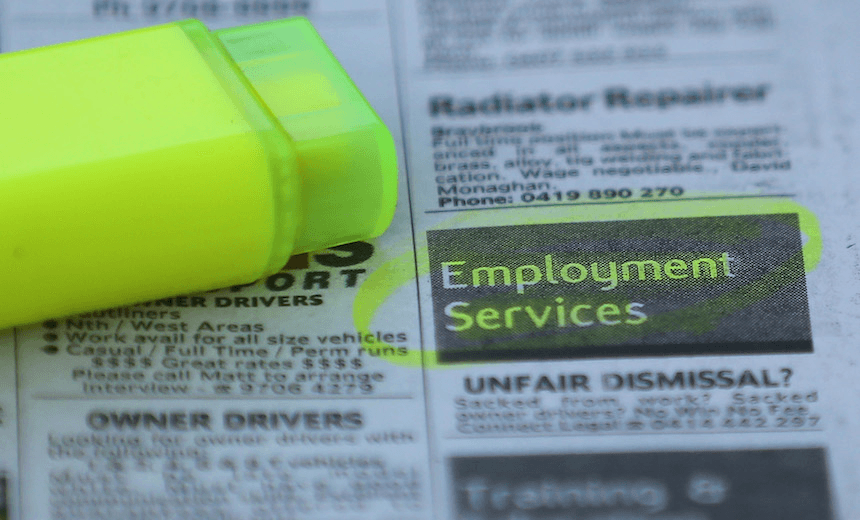New Zealand’s unemployment rate has just fallen, defying experts and flying in the face of everything we expected. But according to Stats NZ, the devil is in the detail.
What’s all this then?
In a bizarre turn of events, New Zealand’s seasonally adjusted unemployment rate has actually fallen from 4.2% to 4% for the June quarter, according to the Household Labour Force Survey released by Stats NZ today.
The survey, which polls 15,000 to 16,000 households, provided the first official employment statistics from across April, May and June – the months including and immediately following New Zealand’s level four lockdown.
The figure has defied many expert predictions, which had forecasted the rate to rise to between 5% and 6% as a result of the massive economic impacts from Covid-19.
According to Stats NZ, the number of people not in the labour force has risen 37,000 this quarter. The number of employed people fell 11,000.
Why has it gone down?
While the lower rate seems like fantastic news, it doesn’t paint a complete picture due to the way Stats NZ has calculated the data. To be counted as unemployed, a person must not have a job, have been actively seeking work in the last four weeks, or be due to start a new job in the next four weeks.
This means that people who weren’t actively seeking work weren’t counted as unemployed in the survey, including those on the wage subsidy who, for whatever reason, weren’t utilised in actual work.
These people were therefore captured in the underutilisation rate, which has increased from 10.4% to 12%. According to Stats NZ, underutilisation includes three other groups of people in the labour market:
- Underemployed – those who are employed part time (working fewer than 30 hours a week) and have both the desire and availability to increase the number of hours they work
- Available potential jobseekers – people who would like a job but are not currently actively seeking one. For example, a university student who’s just graduated and wants a job but isn’t actively applying for one yet
- Unavailable jobseekers – people who are currently looking for a job but aren’t available to start just yet. For example, a mother who’s recently been looking after a child and in the next month will be able to start working again.
Stats NZ’s labour market and household statistics senior manager Sean Broughton said the underutilisation rate along with hours worked provided a more detailed picture of New Zealand’s labour market than the unemployment rate alone.
“At the end of June, there were around 39,000 more recipients of Jobseeker Support than at the end of March, but Jobseeker Support recipients are not necessarily unemployed.”
“This quarter, underutilisation rose from 10.4% to 12.0% – the largest quarterly rise since the series began, while hours worked were down by over 10% – another record.”
What about the “hours worked” figures?
Along with the underutilisation rate, the hours worked figures collected in the survey provide a more comprehensive insight into the degree people are actually being employed working.
Stats NZ has reported that the total number of hours actually worked in the June 2020 quarter fell 9.3 million hours (or 10.3%) compared with the last quarter and decreased 8.2 million hours (or 9.1%) compared with a year ago. These were the largest decreases recorded since the series began in 1986.
Will the unemployment rate get worse?
Because the unemployment figures have omitted those still on the wage subsidy but not actually working, unemployment is bound to increase and more people will move from underutilised to officially unemployed once the wage subsidy extension ends in August and September.
“The government’s extended wage subsidy is on track to end next month. And the situation offshore has deteriorated in recent weeks. We’re still forecasting an unemployment rate that will peak above 9% by the end of 2020,” said Kiwibank chief economist Jarrod Kerr.
Many New Zealand businesses have also enjoyed a surge in spending and retail activity through the June quarter, which experts say is the result of pent up demand from the lockdown.
With the spending spree expected to eventually fizzle out, more businesses may be forced to lay off staff to get through the slump, adding to overall unemployment.
“The initial sugar rush as we came out of lockdown has meant that many businesses have seen a spike in activity,” economist Benje Patterson told RNZ.
“As we move into the second half of 2020 many people are going to begin to roll off the wage subsidies, and it’s at that point that some businesses are going to have to make tough decisions.”
